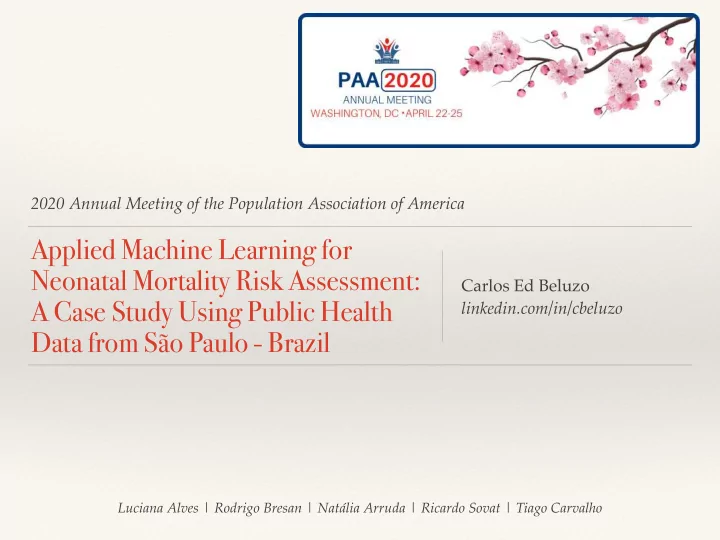

2020 Annual Meeting of the Population Association of America Applied Machine Learning for Neonatal Mortality Risk Assessment: Carlos Ed Beluzo A Case Study Using Public Health linkedin.com/in/cbeluzo Data from São Paulo - Brazil Luciana Alves | Rodrigo Bresan | Natália Arruda | Ricardo Sovat | Tiago Carvalho
Background ❖ Computer Science Professor @ Federal Institute of São Paulo (IFSP) ❖ Data Science postgraduate course creation committee member @ IFSP ❖ Research group deputy leader @ PICAp - IFSP ❖ Ph.D Candidate @ University of Campinas, Department of Demography - (Unicamp) Supervisor : Luciana Correia Alves ❖ Data Science Research Project Manager and co-PI (Bill & Melinda Gates Foundation grant) ❖ Decision-Making Support Platform Based on Visual Analytics and Machine Learning to Subsidize Public Politics Focused on Gestational Health ❖ B.A. Informatics (2002), MSc. in Mechanical Engineering (2006), more than 10 years experience with Databases & Software Development ❖ Interesting fields : Applied Computer Systems; Demography methods; Data Science; Project Management; Agile Methodologies; Databases; Big Data.
Agenda 1. Overview 2. The Proposal 3. The Dataset 4. The Method 5. Experiments and Results 6. Conclusion and Research Directions
Overview ❖ Infant mortality ❖ Reflection of a complex combination of factors: ❖ Biological, socioeconomic, health care, etc ❖ Requires various data sources for a thorough analysis; ❖ Specialized tools/techniques to deal with a large volume of data. ❖ Research Question: Is it possible to “predict” neonatal mortality using this framework? ❖ Machine Learning (ML) has been applied to solve problems from many domain ❖ Presents great potential for this problem too. 1
The Proposal ❖ A method to perform neonatal death risk assessment using ML ❖ Using mother, pregnancy care and child at birth features ❖ Public health dataset containing neonatal samples (deaths/alive) ❖ Encodes feature vectors into images and classifies images using ML ❖ Custom convolutional neural network (CNN) ❖ As results the method classifies samples as death or alive ❖ Method is able to detect death samples with accuracy of 90.61% . 2
The Dataset Brazilian Information Brazilian Information System of Mortality System of Live Births SINASC SIM Linkage - city = “São Paulo” nu_do nu_do - period = [2012, 2018] birth date death date - 1.4 mi samples - 0.??% death birth location age SPNeoDeath schooling birth date sex occupation - Neonatal deaths only APGAR score children - 4 mil samples weeks of gestation delivery type prenatal appointments anomalies WHERE SIM.nu_do == SINASC.nu_do … AND (SIM.death_date - SINASC.birth_date) < 29 . . . . . . 3
The Method 1 - Features Selection DATASUS SIM SINASC SPNeoDeath Data Preprocessing - 36 features (mother and new born) Linkage - 1.4mi samples labeled as death/alive 2 - Feature Transformation 3 - Model Creation 4
Experiments and Results ❖ Round #1: DemogNet with Balanced Dataset ❖ Round #2: DemogNet with Unbalanced Dataset ❖ Round #3: Standard Classifiers for Benchmark ❖ SVM (Support Vector Machines) ❖ KNN (K-Nearest Neighbor) ❖ Round #4: Providing Model Understanding ❖ SHAP (SHapley Additive exPlanation) 5
Experiments and Results 5
Conclusion and Research Directions ❖ A new method to address neonatal death risk problem ❖ SINASC X SIM (1.4m) categorical: mother, pregnancy care, child features at born, etc. ❖ A new approach to encode this categorical data into small gray scale images. ❖ Problem modeled as a binary classification of death and living classes ❖ DemogNet implementation, new CNN architecture ❖ Effectiveness of model classification, achieving an AUC value of 0.96 ❖ Experiments demonstrate that DemogNet outperform standard machine learning methods; ❖ Experiments to understand what contributes to model final answer, ❖ Method limitations: Post born features / dataset bias ❖ Future works : Applies with other datasets ( BRNeoDeath is in progressing) 6
Acknowledgment This work is supported by: Bill & Melinda Gates Foundation [OPP1201970]; - Brazilian Ministry of Health, Brazilian National Council for Scientific and Technological Development [443774/2018-8]; - NVIDIA corporation for supporting our research with a TITAN Xp GPU donation; - Center for Information Technology Renato Archer (CTI). -
Thanks cbeluzo@gmail.com
Recommend
More recommend